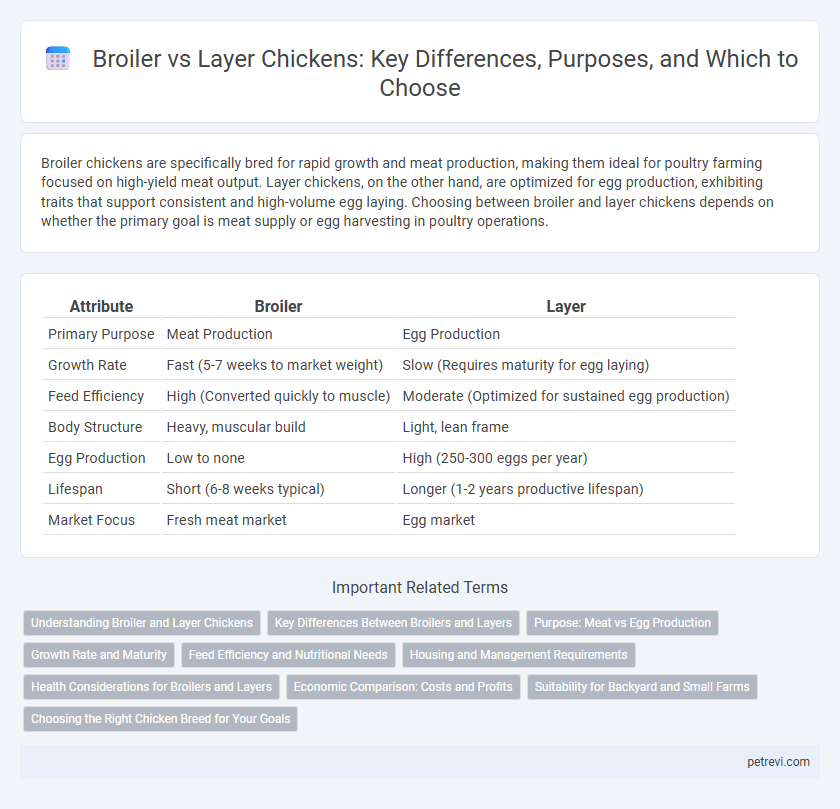Broiler chickens are specifically bred for rapid growth and meat production, making them ideal for poultry farming focused on high-yield meat output. Layer chickens, on the other hand, are optimized for egg production, exhibiting traits that support consistent and high-volume egg laying. Choosing between broiler and layer chickens depends on whether the primary goal is meat supply or egg harvesting in poultry operations.
Table of Comparison
| Attribute | Broiler | Layer |
|---|---|---|
| Primary Purpose | Meat Production | Egg Production |
| Growth Rate | Fast (5-7 weeks to market weight) | Slow (Requires maturity for egg laying) |
| Feed Efficiency | High (Converted quickly to muscle) | Moderate (Optimized for sustained egg production) |
| Body Structure | Heavy, muscular build | Light, lean frame |
| Egg Production | Low to none | High (250-300 eggs per year) |
| Lifespan | Short (6-8 weeks typical) | Longer (1-2 years productive lifespan) |
| Market Focus | Fresh meat market | Egg market |
Understanding Broiler and Layer Chickens
Broiler chickens are specifically bred for rapid growth and meat production, reaching market weight in approximately 6 to 8 weeks, making them ideal for poultry meat purposes. Layer chickens, in contrast, are optimized for egg production, producing high quantities of eggs daily with a focus on shell quality and consistent laying cycles. Understanding the distinct breeding, nutrition, and management requirements of broilers and layers is essential for efficient poultry farming and maximizing productivity.
Key Differences Between Broilers and Layers
Broilers are bred primarily for rapid growth and high meat yield, reaching market weight in 6-8 weeks, while layers are specialized for consistent egg production, typically laying 250-300 eggs per year. Broilers have a heavier, bulkier body structure optimized for meat quality, whereas layers have a leaner physique with enhanced reproductive capabilities. Nutritional requirements and housing management also differ significantly, with broilers needing high-protein diets for muscle development and layers requiring balanced nutrition to maintain egg production and shell quality.
Purpose: Meat vs Egg Production
Broiler chickens are specifically bred for rapid growth and efficient meat production, reaching market weight in as little as six to eight weeks. Layer chickens are optimized for high egg production, producing a steady supply of eggs over a longer period with less emphasis on body mass. The distinct genetic traits between broilers and layers reflect their specialized purposes: broilers maximize meat yield while layers maximize egg output.
Growth Rate and Maturity
Broiler chickens are selectively bred for rapid growth, reaching market weight in approximately 6 to 7 weeks with an average daily gain of 50 grams, making them ideal for meat production. Layer chickens mature more slowly, typically taking 18 to 20 weeks to begin egg-laying, with a primary focus on high egg yield rather than body mass. The significant difference in growth rate and maturity between broilers and layers reflects their specialized genetic traits tailored for meat versus egg production efficiency.
Feed Efficiency and Nutritional Needs
Broiler chickens are bred for rapid growth and meat production, exhibiting higher feed efficiency compared to layers, converting feed into body mass at a faster rate. Layers prioritize egg production, requiring diets rich in calcium and specific nutrients to support high egg yield and shell quality, differing significantly from broiler nutritional formulations. Optimizing feed for broilers focuses on energy and protein density, while layers need balanced vitamins and minerals to maintain reproductive health and egg quality.
Housing and Management Requirements
Broiler chickens require spacious, well-ventilated housing with controlled temperature and humidity to support rapid growth and prevent heat stress, emphasizing frequent litter maintenance to avoid disease. Layer chickens need well-lit, clean housing with nesting boxes and perches, alongside carefully managed lighting schedules to optimize egg production and consistent feeding routines to maintain health. Both types demand biosecurity measures, but layers require more precise environmental control for consistent egg laying compared to broilers focused on meat yield.
Health Considerations for Broilers and Layers
Broilers are bred for rapid growth and meat production, which can lead to health issues such as skeletal disorders, respiratory problems, and a higher susceptibility to infections due to their fast metabolism and dense muscle mass. Layers, optimized for egg production, often face challenges like osteoporosis and calcium deficiency, which affect eggshell quality and overall bone health. Proper nutrition, housing conditions, and veterinary care are essential to mitigate health risks specific to broilers and layers, ensuring optimal welfare and productivity.
Economic Comparison: Costs and Profits
Broilers are raised primarily for meat production, resulting in faster weight gain and higher market turnover, which translates to quicker profits despite higher feed costs. Layers focus on egg production, offering steady income through continuous egg sales but incur ongoing maintenance costs for longer lifespans. Economically, broiler farming yields higher short-term profits, while layer farming provides sustainable, long-term income with lower daily expenses.
Suitability for Backyard and Small Farms
Broiler chickens are ideal for backyard and small farms focused on meat production due to their rapid growth rate and efficient feed conversion. Layer chickens suit small-scale operations aimed at consistent egg production, offering high egg yield and adaptability to limited space. Choosing between broilers and layers depends on the primary purpose--meat versus eggs--and the specific management practices of the farm.
Choosing the Right Chicken Breed for Your Goals
Broilers are specifically bred for rapid growth and high meat yield, reaching market weight in as little as six to eight weeks, making them ideal for meat production. Layers, on the other hand, are optimized for egg production, consistently laying large quantities of eggs over their lifespan. Choosing the right breed depends on your goals: prioritize broilers for efficient meat output and layers for maximum egg quantity and quality.
Broiler vs Layer for Chicken Purpose Infographic

 petrevi.com
petrevi.com